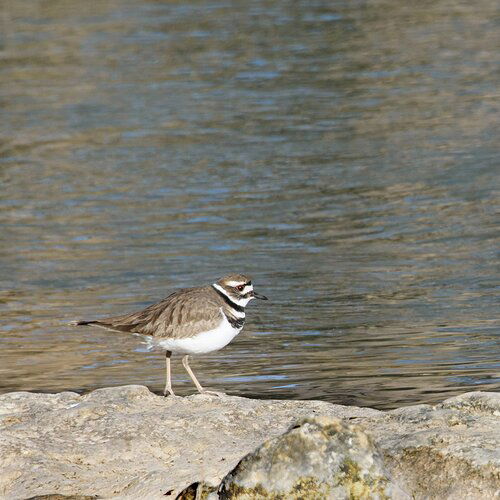On a recent hike to a local nature trail I discovered this Killdeer (Plover family, I believe.). There were several of them mostly just hanging around and enjoying the warm morning sun. Since I am not very accomplished at photographing birds I decided this would be a good time for me to get some much needed practice.
My frustration is I do not seem to be able to get clear detail in the bird. I experimented with lower aperture, higher ISO, faster/slower ss. This image was the best of the lot. Any, and all, suggestions, thoughts and comments about how to get the wonderful detail all of you other Avian photographers get would be welcome.
Does the composition give a sense of place?
Nikon D7200, f/10, 1000 sec., iso 800, 28-300mm @300mm. Tripod. Taken at 9:30am, winds were about 10mph.
LR: cropped 1:1, noise reduction on water and texture/clarity on bird. PS: luminosity mask to burn down the very bright limestone rocks in the foreground.
Thank you.
Hi Linda. It’s a well composed image and given the size of the Killdeer in the frame it is fairly sharp. As you say, it could be even more so. Since you say you tried a lot of variations, I’d look at your lens. I’m not familiar with Nikon lenses, but a lot of lenses with that much zoom lose sharpness at the long end. You might try some test shots under controlled conditions just using a piece of paper with some lines forming a grid. Use the 2 second timer or a cable release and try full zoom and then backing off a bit to see if it makes a difference.
The other thing I’d look at, if you’re not doing it already, is to set your camera up for back-button focus. Then you can use the smallest focus area available to put your focus right on the eye of the bird then recompose and shoot without disturbing the focus.
2 Likes
You certainly did well to get close to the Killdeer. They always seem a jittery bird to me. You have a very nice pose from the bird with good eye contact. I might crop a sliver off the bottom to lose that little bit of fg rock. Also you might think about a pano type crop to lose some of the water.
The camera settings look very generous so you were not light challenged. Typically for birds you are shooting with long to very long focal lengths. Therefore you want to keep ss up which may up the ISO and need wide open apertures.
Looking at the larger version and rock on which the bird is standing is the focus slightly in front of the bird? You probably have a better view on the original photo.
I am not familiar with the lens either but sometimes just backing off a very little bit from the full focal length improves IQ.
Looking forward to seeing more.
For a subject this small in the frame, at a relatively high ISO, you can’t get much detail. I’d crop from the top to halfway to the head, and that leaves you with maybe 25% of the full frame, so that’s a penalty for detail right there. Nailing focus exactly on the subject is key to sharpness, as is a steady camera (although you used a tripod, there is a lot of variability in how steady a tripod is and how good the image stabilization is). Getting close to the subject is key, and with a skittish small bird, 300mm is usually not enough.
The whites look blown, too, and that can cause loss if detail. Just the other day I discovered a webinar by @David_Kingham on “Rethinking Lightroom” (applies to ACR too and maybe other converters). The techniques he shows would let you recover detail in the whites and other tones as well.
But the bottom line is to get the subject large in the frame, with low ISO and high-enough shutter speed.
Thank you @Dennis_Plank, @David_Leroy and @Diane_Miller for your comments and suggestions. I did crop this image to more of a pano configuration and like it a lot better. However, this clearly doesn’t compensate for the other flaws. I’ve been out this morning to the same nature trail and practiced quite a while on a willing Egret. Will post separately, but I am pleased with the changes I’ve made. Coming along, thanks to all of your help.
Linda, you have really got some good advice thus far. I don’t really have anything to add. I am not familiar with an Nikon lenses, as I am a Canon shooter. Sometimes though, you have to calibrate a lens to the camera, because, as David hit on, the focus (when you know for sure you had the focus point on the eye), is front or back focusing. Just have to read up on it in your camera’s user manual if that is the problem. Looking forward to seeing the Egret images. Glad to hear that you feel pleased with the changes.
1 Like
